lock PONTIAC FIREBIRD 1997 Repair Manual
[x] Cancel search | Manufacturer: PONTIAC, Model Year: 1997, Model line: FIREBIRD, Model: PONTIAC FIREBIRD 1997Pages: 410, PDF Size: 19.2 MB
Page 150 of 410
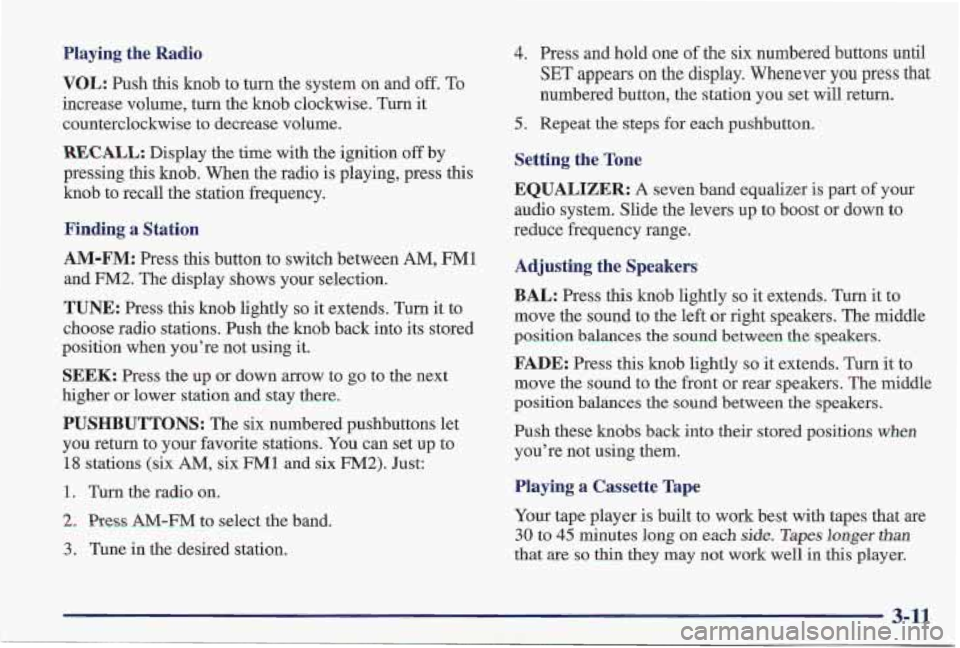
Playing the Radio
VOL: Push this knob to turn the system on and off. To
increase volume, turn the knob clockwise. Turn it
counterclockwise to decrease volume.
RECALL: Display the time with the ignition off by
pressing this knob. When the radio is playing, press this
knob to recall the station frequency.
Finding a Station
AM-FM:
Press this button to switch between AM, FM1
and FM2. The display shows your selection.
TUNE: Press this knob lightly so it extends. Turn it to
choose radio stations. Push the knob back into its stored
position when you’re not using it.
SEEK: Press the up or down arrow to go to the next
higher or lower station and stay there.
PUSHBUTTONS: The six numbered pushbuttons let
you return to your favorite stations.
You can set up to
18 stations (six AM, six FM1 and six FM2). Just:
1. Turn the radio on.
2. Press AM-FM to select the band.
3. Tune in the desired station.
4. Press and hold one of the six numbered buttons until
SET appears on the display. Whenever you press that
numbered button, the station you set will return.
5. Repeat the steps for each pushbutton.
Setting the Tone
EQUALIZER: A
seven band equalizer is part of your
audio system. Slide the levers up to boost or down
to
reduce frequency range.
Adjusting the Speakers
BAL: Press this knob lightly so it extends. Turn it to
move the sound to the left or right speakers. The middle
position balances
the sound between the speakers.
FADE: Press this knob lightly so it extends. Turn it to
move the sound to the front or rear speakers. The middle
position balances the sound between
the speakers.
Push these knobs back into their stored positions
when
you’re not using them.
Playing a Cassette Tape
Your tape player is built to work best with tapes that are
30 to 45 minutes long on e,ach side. Tapes longer than
that are so thin they may not work well in this play’er.
3-11
Page 151 of 410
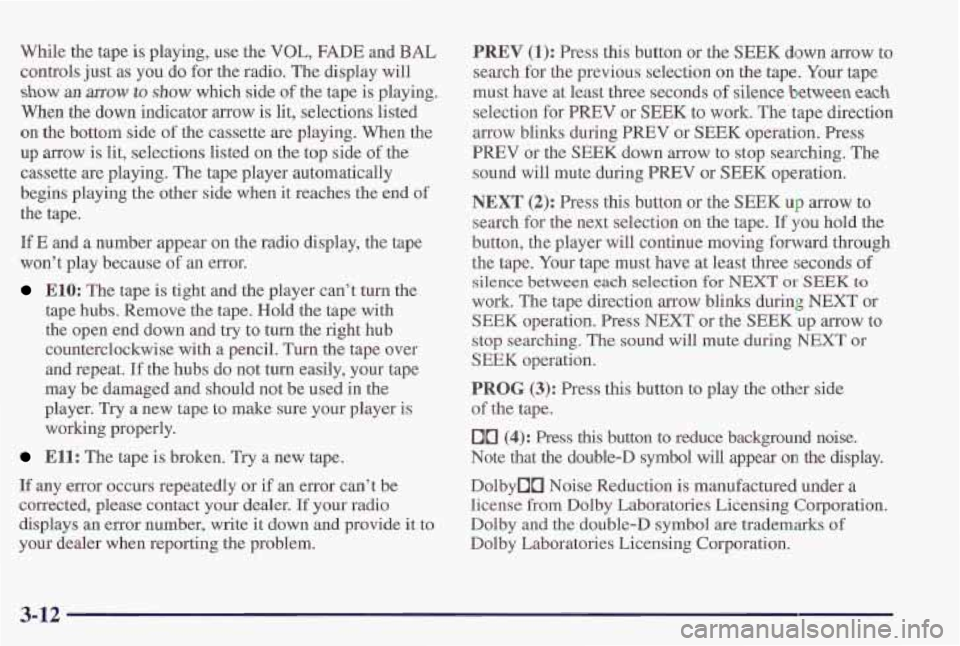
While the tape is playing, use the VOL, FADE and BAL
controls just as you do for the radio. The display will
show an arrow to show which side of the tape is playing.
When the down indicator arrow is lit, selections listed
on the bottom side
of the cassette are playing. When the
up arrow is lit, selections listed on
the top side of the
cassette are playing. The tape player automatically
begins playing the other side when
it reaches the end of
the tape.
If E and a number appear on the radio display, the tape
won’t play because
of an error.
E10: The tape is tight and the player can’t turn the
tape hubs. Remove the tape. Hold the tape with
the open end down and
try to turn the right hub
counterclockwise with
a pencil, Turn the tape over
and repeat. If the hubs do not turn easily, your tape
may be damaged and should not be used
in the
player. Try a new tape
to make sure your player is
working properly.
Ell: The tape is broken. Try a new tape.
If any error occurs repeatedly or if an error can’t be
corrected, please contact your dealer. If your radio
displays an error nuniber, write
it down and provide it to
your dealer when reporting the problem.
PREY (1): Press this button or the SEEK down arrow to
search for the previous selection on the tape. Your tape
must have at least three seconds
of silence between ah
selection for PREV or SEEK to work. The tape direction
arrow blinks during
PREV or SEEK operation. Press
PREV or the SEEK down arrow to stop searching. The
sound will mute during
PREV or SEEK operation.
NEXT (2): Press this button or the SEEK up arrow to
search for the next selection on the tape.
If you hold the
button, the player will continue moving forward through
the tape. Your tape must have at least three seconds
of
silence between each selection for NEXT or’SEEK to
work. The tape direction arrow blinks during NEXT or
SEEK operation. Press
NEXT or the SEEK up arrow to
stop searching. The sound will mute during NEXT or
SEEK operation.
PROG (3): Press this button to play the other side
of the tape.
on (4): Press this button to reduce background noise.
Note that the double-D symbol will appear
on the display,
Dolby00 Noise Reduction
is manufactured under a
license from Dolby Laboratories Licensing Corporation.
Dolby and the double-D symbol
are trademarks of
Dolby Laboratories Licensing Corporation.
3-12
Page 153 of 410
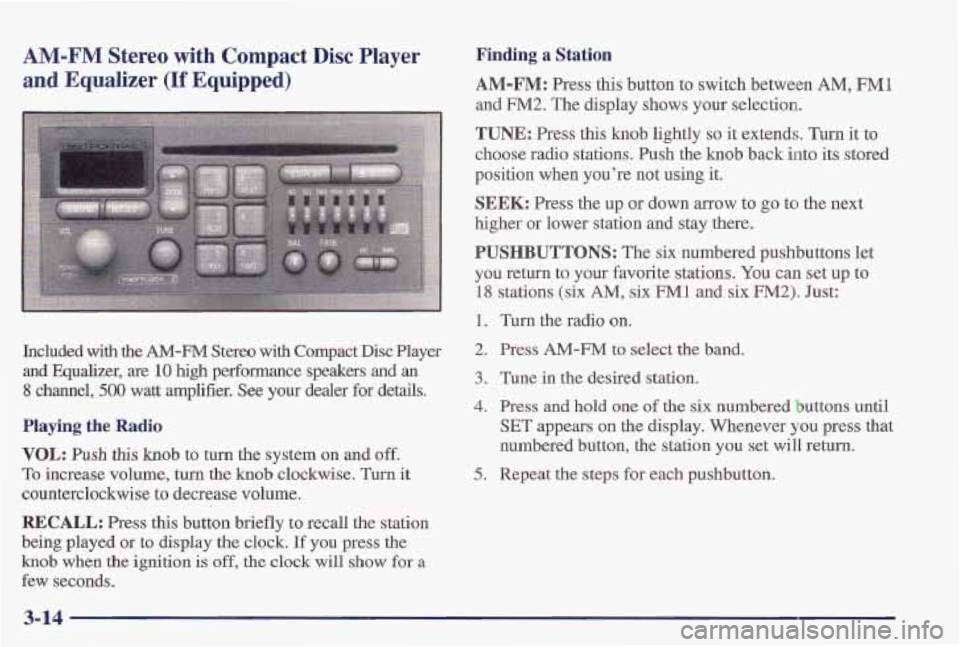
AM-FM Stereo with Compact Disc Player
and Equalizer (If Equipped)
Included with the AM-FM Stereo with Compact Disc Player
and Equalizer, are 10 high performance speakers and an
8 channel, 500 watt amplifier. See your dealer for details.
Playing the Radio
VOL: Push this knob to turn the system on and off.
To increase volume, turn the knob clockwise. Turn it
counterclockwise to decrease volume.
RECALL: Press this button briefly to recall the station
being played or to display the clock. If you press the
knob when the ignition is
off, the clock will show for a
few seconds.
Finding a Station
AM-FM: Press this button to switch between AM, FM1
and
FM2. The display shows your selection.
TUNE: Press this knob lightly so it extends. Turn it to
choose radio stations. Push the knob back into its stored
position when you’re not using it.
SEEK: Press the up or down arrow to go to the next
higher
or lower station and stay there,
PUSHBUTTONS: The six numbered pushbuttons let
you return to your favorite stations. You can set up to
18 stations (six AM, six FM1 and six FM2). Just:
1. Turn the radio on.
2. Press AM-FM to select the band.
3. Tune in the desired station.
4. Press and hold one of the six numbered buttons until
SET appears on the display. Whenever you press that
numbered button, the station you set will return.
5. Repeat the steps for each pushbutton.
3-14
Page 158 of 410
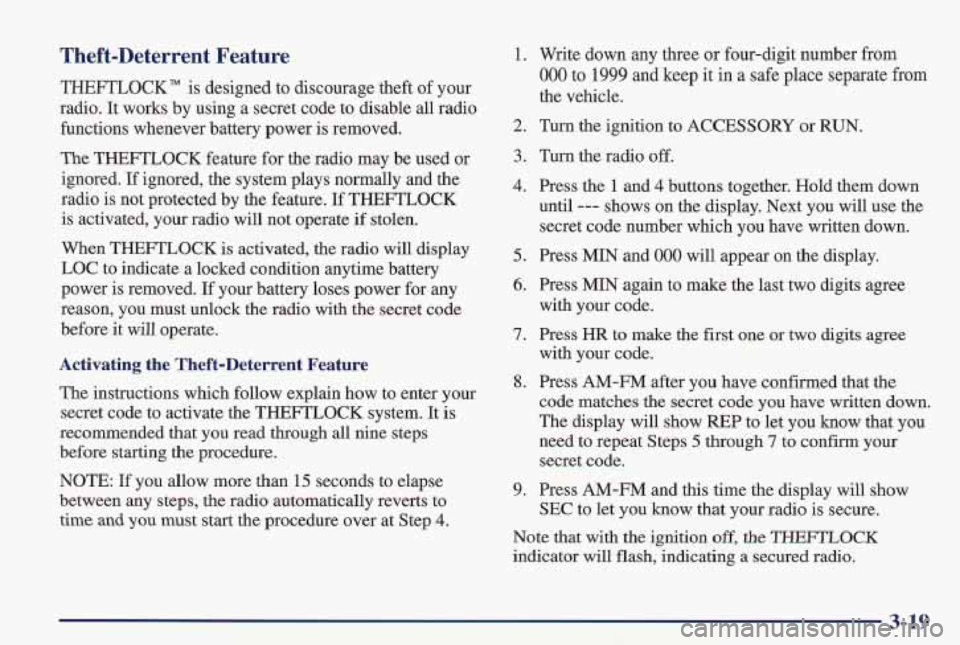
Theft-Deterrent Feature
THEFTLOCK" is designed to discourage theft of your
radio. It works by using
a secret code to disable all radio
functions whenever battery power is removed.
The THEFTLOCK feature for the radio may be used or
ignored.
If ignored, the system plays normally and the
radio is not protected by the feature. If THEFTLOCK
is activated, your radio will not operate
if stolen.
When
THEFTLOCK is activated, the radio will display
LOC to indicate a locked condition anytime battery
power is removed. If your battery loses power for any
reason, you must unlock the radio with the secret code
before it will operate.
Activating the Theft-Deterrent Feature
The instructions which follow explain how to enter your
secret code to activate the THEFTLOCK system. It is
recommended that you read through all nine steps
before starting the procedure.
NOTE:
If you allow more than 15 seconds to elapse
between any steps, the radio automatically reverts to
time and you must start the procedure over at Step 4.
1.
2.
3.
4.
5.
6.
7.
8.
9.
Write down any three or four-digit number from
000 to 1999 and keep it in a safe place separate from
the vehicle.
Turn the ignition to ACCESSORY or RUN.
Turn the radio
off.
Press the 1 and 4 buttons together. Hold them down
until
--- shows on the display. Next you will use the
secret code number which you have written down.
Press MIN and
000 will appear on the display.
Press MIN again to make the last two digits agree
with your code.
Press HR to make the first one or two digits agree
with your code.
Press AM-FM after you have confirmed that the
code matches the secret code you have written down.
The display will show REP to let you know that you
need to repeat Steps
5 through 7 to confirm your
secret code.
Press AM-FM and this time the display will show
SEC to let you know that your radio is secure.
Note that with the ignition
off, the THEFTLOCK
indicator will flash, indicating a secured radio.
3-19
Page 159 of 410

Unlocking the Theft-Deterrent Feature After a
Power Loss
Enter your secret code as follows; pause no more than
15 seconds between steps:
1.
2.
3.
4,
5.
LOC appears when the ignition is on.
Press MIN and
000 will appear can the display.
Press MIN again to make the last two digits agree
with your code.
Press
HR to make the first one or two digits agree
with your code.
Press AM-FM after you have confirmed that the
code matches the secret code you have written down.
The display will show
SEC, indicating the radio is
now operable and secure.
If you enter the wrong code eight times, INOP will appear
on the display. You will have to wait
an hour with the
ignition on before you can try again. When you try again,
you will only have three more chances (eight tries per
chance)
to enter the correct code before INOP appears.
If you lose or forget your code, contact your dealer.
Disabling the Theft-Deterrent Feature
Enter your secret code as follows; pause no more than
15 seconds between steps:
1.
2.
3.
4.
5.
6.
7.
Turn the ignition to ACCESSORY or RUN.
Turn the radio off.
Press the 1 and 4 buttons together. Hold them down
until
SEC shows on the display.
Press MIN and
000 will appear on the display.
Press MIN again to make the last two digits agree
with your code.
Press
HR to make the first one or two digits agree
with your code.
Press
AM-FM after you have confirmed that the
code matches
the secret code you have written down.
The display will show
---, indicating that the radio is
no longer secured.
If the code entered is incorrect, SEC will appear on the
display. The ra’dio will remain secured until the correct
code
is entered.
When battery power is removed and later applied
to a
secured radio, the radio won’t turn
on and LOC will
appear on
the display.
To unlock
a secured radio, see “Unlocking the
Theft-Deterrent Feature After a Power
Loss” earlier in
this section.
Page 172 of 410

Anti-Lock Brakes (ABS)
Your vehicle has anti-lock brakes (ABS). ABS is an
advanced electronic braking system that will help
prevent a braking skid.
When you start your engine, or when you begin to drive
away, your anti-lock brake system will check itself.
You
may hear a momentary motor or clicking noise while
this test is going on, and you may even notice that your
brake pedal moves a little. This is normal.
ABS
INOP
If there’s a problem with the
anti-lock brake system, this
warning light will stay
on or
flash. See “Anti-Lock
Brake System Warning
Light” in the Index.
Here’s how anti-lock works. Let’s say the road
is wet.
You’re driving safely. Suddenly an animal jumps out in
front of you.
You slam on the brakes. Here’s what happens with
ABS.
A computer senses that wheels are slowing down. If one
of the wheels is about to st,op rolling, the computer will
separately work the brakes at each front wheel and at
the
rear wheels.
4-7
Page 173 of 410
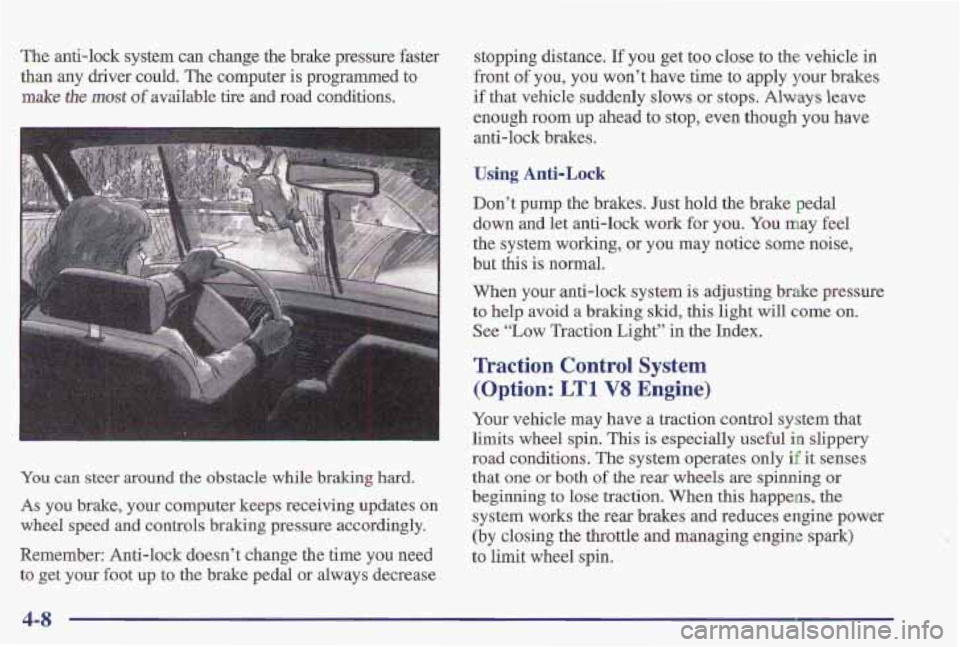
The anti-lock system can change the brake pressure faster
than any driver could. The computer is programmed to
make the most of available tire and road conditions.
You can steer around the obstacle while braking hard.
As you brake, your computer keeps receiving updates on
wheel speed and controls braking pressure accordingly.
Remember: Anti-lock doesn’t change the time
you need
to get your foot up to the brake pedal or always decrease stopping distance.
If you
get too close to the vehicle in
front
of you, you won’t have time to apply your brakes
if that vehicle suddenly slows or stops. Always leave
enough room up ahead to stop, even though you have
anti-lock brakes.
Using Anti-Lock
Don’t pump the brakes. Just hold the brake pedal
down and let anti-lock work for you.
You may feel
the system working, or you may notice some noise,
but this is normal.
When your anti-lock system
is adjusting brake pressure
to help avoid a
braking skid, this light will come on.
See
“Low Traction Light” in the Index.
Traction Control System
(Option: LTI V8 Engine)
Your vehicle may have a traction control system that
limits wheel spin. This
is especially useful in slippery
road conditions. The system operates only
if it senses
that one or
both of the rear wheels are spinning or
beginning to lose traction. When this happens,
the
system works the rear brakes and reduces engine power
(by closing the throttle and managing engine spark)
to limit wheel spin.
Page 175 of 410

To turn the system off, press
the button located at the
front
of the console.
The light on
the switch will go off, and the traction
control system warning light will come on and stay on.
If the traction control system is limiting wheel spin
when
you press the switch, the light on the switch will
go off and the warning light will come on -- but the
system won’t turn
off right away. It will wait until
there’s
no longer a current need to limit wheel spin.
You can turn the system back on at any time by pressing
the switch again. The light
on the button should come
on, and the traction control system warning light should
go off. If
your car is equipped with P245/5OZR16 tires, the
traction control system will automatically turn
off at
speeds above 108 mph
(174 km/h). (The traction control
system warning light will not come on.) When the
vehicle speed drops below
103 mph (166 kmh) the
system will automatically come on again.
Braking in Emergencies
With anti-lock, you can steer and brake at the same
time.
In many emergencies, steering can help you more
than even the very best braking.
Steering
Power Steering
If you lose power steering assist because the engine
stops or the system is not functioning, you can steer but
it will take much more effort.
Steering Tips
Driving on Curves
It’s important to take curves at a reasonable speed.
4- 10
Page 177 of 410

Off-Road Recovery
You may find sometime that your right wheels have
dropped
off the edge of a road onto the shoulder while
you’re driving.
An emergency like this requires close attention and a
quick decision. If you are holding the steering wheel at
the recommended
9 and 3 o’clock positions, you can
turn
it a full 180 degrees very quickly without removing
either hand. But you have
to act fast, steer quickly, and
just
as quickly straighten the wheel once you have
avoided the object.
The fact that such emergency situations are always
possible
is a good reason to practice defensive driving at
all times and wear safety belts properly.
I OFF-ROAD RECOVERY / ,
I
I
’/// edge of paved surface
If the level of the shoulder is only slightly below the
pavement, recovery should be fairly easy. Ease
off the
accelerator and then, if there is nothing in the way, steer so
that your vehicle straddles the edge of the pavement. You
can
turn the steering wheel up to one-quarter turn until the
right front tire contacts the pavement edge. Then turn your
steering wheel to
go straight down the roadway.
4-12
Page 180 of 410

If you do not have traction control, or if the system is
off, then an acceleration skid is also best handled by
easing your foot off the accelerator pedal.
If your vehicle starts to slide, ease your foot off the
accelerator pedal and quickly steer the way you want the
vehicle to go. If you start steering quickly enough, your
vehicle may straighten out. Always be ready for a
second skid
if it occurs.
Of course, traction is reduced when water, snow, ice,
gravel or other material is on the road. For safety, you’ll
want to slow down and adjust your driving to these
conditions. It
is important to slow down on slippery
surfaces because stopping distance will be longer and
vehicle control more limited.
While driving on a surface with reduced traction, try
your best to avoid sudden steering, acceleration
or
braking (including engine braking by shifting to a
lower gear). Any sudden changes could cause the tires
to slide.
You may not realize the surface is slippery until
your vehicle is skidding. Learn to recognize warning
clues
-- such as enough water, ice or packed snow on
the road to make a “mirrored surface” -- and slow down
when you have any doubt.
Remember: Any anti-lock brake system
(ABS) helps
avoid only the braking skid.
Driving at Night
I
.A
Night driving is more dangerous than day driving.
One reason is that some drivers are likely
to be
impaired -- by alcohol or drugs, with night vision
problems, or by fatigue.
4-15